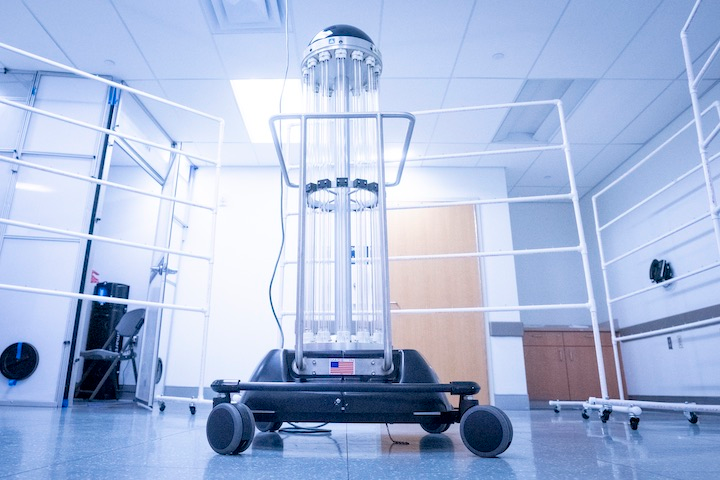Apr 16 2020
A thin layer of personal protective equipment (PPE), including gloves, masks, and gowns, lies between the ability of health care professionals at the forefront of the COVID-19 pandemic to help patients and the chances of becoming patients themselves.
 A newly acquired robot, Tru-D, can disinfect up to 6,000 N-95 masks per day. Image Credit: UVA Health.
A newly acquired robot, Tru-D, can disinfect up to 6,000 N-95 masks per day. Image Credit: UVA Health.
A new robot obtained by the University of Virginia Health System (UVA Health) has been helping to increase the service life of some of the most vital PPE, during the increased surge in demand for these items.
Measuring 5 feet 6 inches high, the robot named “Tru-D” makes use of UV light vectors or UV germicidal irradiation to disinfect porous and non-porous surfaces without the use of toxic chemicals. The robot was acquired by UVA Health and assembled, and staff were training to use and operate it in just five days this month.
The robot is able to sanitize up to 6,000 N-95 masks every day. This support could prove crucial since UVA Health predicts that a huge number of patients suffering from the coronavirus disease will need care in the following weeks.
The safety of our patients and team members is, and always will be, our highest priority. That said, we have been pushed to a place where merely purchasing the best products is no longer an option; there are none to purchase. There has never been a more crucial time, nor a need so great to become a thinker out of the box … Think, plan, do.
Carlene Muto, MD and Assistant Professor of Infectious Diseases and International Health, UVA Health
The focus of Muto’s research is on infectious diseases and hospital epidemiology.
Muto continued, “As research began circulating on using UV to disinfect PPE, we went to work to determine what resources we needed to do it best, and people across the organization responded. Tru-D uses indirect UV sources. The robot uses size and density sensors to calibrate the exact dose of energy necessary to disinfect the entire room.”
“Light is emitted, then reflected back so all surfaces receive the required energy. This ensures ‘Total Room Ultraviolet Disinfection (Tru-D)’ of all surfaces, including shadowed or hidden areas. Use of reflective surfaces increases the efficiency of the device, so the room was painted with reflective paint,” added Muto.
UV light emits high energy, which is absorbed in the cellular DNA and RNA of microorganisms, affecting the nucleic acids and hindering their reproduction. They are then unable to infect humans or survive.
The Tru-D robot is well-equipped to optimize the efficiency of disinfecting hundreds of masks for every 20-minute cycle. The entire cycle time taken by the robot to prepare masks for disinfection and recover them for repackaging is slightly less than one hour.
At present, the advanced technology is being used at UVA Health thanks to the quick work of epidemiology, clinical staff, procurement, clinical engineering, supply chain, environmental services, senior leadership teams, and central sterile processing group, who obtained, shipped, assembled, trained staff, and made Tru-D operational within a week.
The robot is large, fragile and incredibly valuable, yet we needed to get it operational as quickly as possible.
Michael Friesen, Director of Clinical Engineering, UVA Health
Along with Friesen, Patrick Headley—manager of clinical engineering professional services—traveled to Tennessee, US, to acquire the machine and train themselves on its use.
This is truly an all-hands-on-deck situation, and every hour and day is important as we work to prepare for a potential surge of COVID-19 patients here in Charlottesville. We were on our way Monday morning, returned home that afternoon with Tru-D in hand and had the robot’s UV light up and running by Tuesday afternoon.
Patrick Headley, Manager of Clinical Engineering Professional Services, UVA Health
According to K. Craig Kent, MD and executive vice president for health affairs, “By utilizing Tru-D, we can extend our current supply of personal protective equipment to meet the essential needs of our frontline faculty and staff.”
Kent continued, “UVA Health will continue to do all we can—from supply chain management to clinical innovations—to ensure every person in our facilities is safe and protected. Doing so allows us to provide outstanding care to patients in need.”